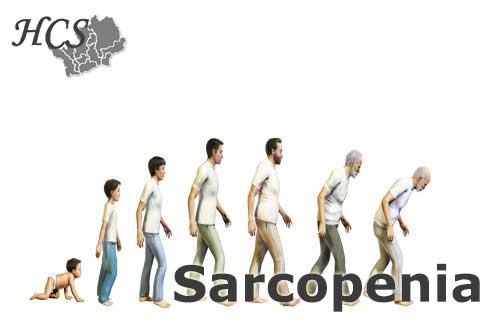Sarcopenia
As we age, we naturally lose muscle and become weaker, in a process called sarcopenia; this can result in frailty or disability and increase our risk of falls.
It may be obvious to older people themselves, but until recently the problem has received little attention from the medical profession. With your help, we have investigated ways of measuring the size and strength of muscles, and we are beginning to understand what influences them in later life.
The quickest, cheapest and easiest way to assess muscle strength is by squeezing a hand grip dynamometer. Nearly everyone who came to our clinics took this test; many also had the strength of their thighs measured by pushing against a weight whilst lying down. After this first assessment, some people returned to local clinics to have the size, rather than the strength, of their muscles measured using a DXA scanner, or travelled to Cambridge where there is a more specialised scanning machine. A small number of people were invited to our clinical research unit at Southampton General Hospital where a tiny piece of muscle was taken from their thigh under local anaesthetic and examined under a microscope.
Findings from these studies include:
Experiences in the womb and early in life affect the amount of muscle we build. For example, people who were smaller babies had lower density of muscle fibres in later life and were less strong. Meanwhile, men who were breast-fed as babies were stronger than those who were not, but this was not so in women.
Experiences in adult life affect the amount of muscle we lose, for example inflammatory processes lower grip strength whilst diet may help protect us – people who ate more oily fish were stronger.
Loss of muscle has serious consequences: people with lower grip strength in clinic had worse quality of life (assessed by questionnaire) and higher levels of disability than others.
Lately, doctors have defined a cut-point in muscle, below which a condition called sarcopenia is defined (in the same way that a cut-point in the amount of haemoglobin in blood defines anaemia). Using this new cut-point, we have shown that around 5% of men and 8% of women in HCS had sarcopenia.
The practical outcome of this research is that the importance of muscle size and strength in later life is much more widely acknowledged – before long we expect to see grip strength measurement used routinely in geriatric clinics across the country, helping to identify people who might struggle to care for themselves.
Reference List
MA Burton, E Antoun, ES Garratt, L Westbury, EM Dennison, NC Harvey, C Cooper, HP Patel, KM Godfrey, KA Lillycrop. The serum small non coding RNA (SncRNA) landscape as a molecular biomarker of age associated muscle dysregulation and insulin resistance in older adults. FASEB J . 2024 Feb 15;38(3):e23423. doi: 10.1096/fj.202301089RR. PMID: 38294260.
Mark A. Burton, Elie Antoun, Emma S. Garratt, Leo Westbury, Alica Baczynska, Elaine M. Dennison, Nicholas C. Harvey, Cyrus Cooper, Harnish P. Patel, Keith M. Godfrey, Karen A. Lillycrop, EpiGen Global Research Consortium. Adiposity is associated with widespread transcriptional changes and downregulation of longevity pathways in aged skeletal muscle. Journal of cachexia, sarcopenia and muscle 14 (4), 1762-1774. 18 May 2023. doi.org/10.1002/jcsm.13255
Westbury LD, Beaudart C, Bruyère O, Cauley JA, Cawthon P, Cruz-Jentoft AJ, Curtis EM, Ensrud K, Fielding RA, Johansson H, Kanis JA, Karlsson MK, Lane NE, Lengelé L, Lorentzon M, McCloskey E, Mellström D, Newman AB, Ohlsson C, Orwoll E, Reginster JY, Ribom E, Rosengren BE, Schousboe JT, Shiroma EJ, Harvey NC, Dennison EM, Cooper C; International Musculoskeletal Ageing Network. Recent sarcopenia definitions-prevalence, agreement and mortality associations among men: Findings from population-based cohorts. J Cachexia Sarcopenia Muscle. 2023 Feb;14(1):565-575. doi: 10.1002/jcsm.13160. Epub 2023 Jan 5. PMID: 36604970; PMCID: PMC9891989.
Mark A. Burton, Emma S. Garratt, Matthew O. Hewitt, Hanan Y. Sharkh, Elie Antoun, Leo D. Westbury, Elaine M. Dennison, Nicholas C. Harvey, Cyrus Cooper, Julia L. MacIsaac, Michael S. Kobor, Harnish P. Patel, Keith M. Godfrey & Karen A. Lillycrop. DNA methylation of insulin signaling pathways is associated with HOMA2-IR in primary myoblasts from older adults. Skeletal Muscle 13, 17 (2023). doi.org/10.1186/s13395-023-00326-y
Laskou F, Westbury LD, Fuggle NR, Harvey NC, Patel HP, Cooper C, Ward KA, Dennison EM. Determinants of muscle density and clinical outcomes: Findings from the Hertfordshire Cohort Study. Bone. 2022 Nov;164:116521. doi: 10.1016/j.bone.2022.116521. Epub 2022 Aug 17. PMID: 35985467.
Laskou F, Westbury LD, Fuggle NR, Edwards MH, Cooper C, Dennison EM. Relationships Between Muscle Parameters and History of Falls and Fractures in the Hertfordshire Cohort Study: Do All Muscle Components Relate Equally to Clinical Outcomes? Calcif Tissue Int. 2022 Sep;111(3):242-247. doi: 10.1007/s00223-022-00986-w. Epub 2022 May 19. PMID: 35590077; PMCID: PMC9395432.
Laskou F, Fuggle NR, Patel HP, Jameson K, Cooper C, Dennison E. Associations of osteoporosis and sarcopenia with frailty and multimorbidity among participants of the Hertfordshire Cohort Study. J Cachexia Sarcopenia Muscle. 2022 Feb;13(1):220-229. doi: 10.1002/jcsm.12870. Epub 2021 Dec 6. PMID: 34873876; PMCID: PMC8818662.
Elie Antoun, Emma S. Garratt, Andrea Taddei, Mark A. Burton, Sheila J. Barton, Phil Titcombe, Leo D. Westbury, Alicia Baczynska, Eugenia Migliavacca, Jerome N. Feige, Holly E. Sydall, Elaine Dennison, Richard Dodds, Helen C. Roberts, Peter Richardson, Avan A. Sayer, Sarah Shaw, Cyrus Cooper, Joanna D. Holbrook, Harnish P. Patel, Keith M. Godfrey, Karen A. Lillycrop, the EpiGen Global Research Consortium. Epigenome-wide association study of sarcopenia: findings from the Hertfordshire Sarcopenia Study (HSS). Journal of Cachexia, Sarcopenia and Muscle 13 (1), 240-253. 2021 Dec 4.
Parsons CM, Edwards MH, Cooper C, Dennison EM, Ward KA. Are jumping mechanography assessed muscle force and power, and traditional physical capability measures associated with falls in older adults? Results from the Hertfordshire Cohort Study. J Musculoskelet Neuronal Interact. 2020 Jun 1;20(2):168-175. PMID: 32481232; PMCID: PMC7288388.
Migliavacca E, Tay SKH, Patel HP, Sonntag T, Civiletto G, McFarlane C, Forrester T, Barton SJ, Leow MK, Antoun E, Charpagne A, Seng Chong Y, Descombes P, Feng L, Francis-Emmanuel P, Garratt ES, Giner MP, Green CO, Karaz S, Kothandaraman N, Marquis J, Metairon S, Moco S, Nelson G, Ngo S, Pleasants T, Raymond F, Sayer AA, Ming Sim C, Slater-Jefferies J, Syddall HE, Fang Tan P, Titcombe P, Vaz C, Westbury LD, Wong G, Yonghui W, Cooper C, Sheppard A, Godfrey KM, Lillycrop KA, Karnani N, Feige. Mitochondrial oxidative capacity and NAD+ biosynthesis are reduced in human sarcopenia across ethnicities. JN.Nat Commun. 2019 Dec 20;10(1):5808. doi: 10.1038/s41467-019-13694-1.PMID: 31862890 Free PMC article.
Pinedo-Villanueva R, Westbury LD, Syddall HE, Sanchez-Santos MT, Dennison EM, Robinson SM, Cooper C. Health Care Costs Associated With Muscle Weakness: A UK Population-Based Estimate. Calcif Tissue Int. 2019 Feb;104(2):137-144. doi: 10.1007/s00223-018-0478-1. Epub 2018 Sep 22. PMID: 30244338; PMCID: PMC6330088.
Westbury LD, Dodds RM, Syddall HE, Baczynska AM, Shaw SC, Dennison EM, Roberts HC, Sayer AA, Cooper C, Patel HP. Associations Between Objectively Measured Physical Activity, Body Composition and Sarcopenia: Findings from the Hertfordshire Sarcopenia Study (HSS). Calcif Tissue Int. 2018 Sep;103(3):237-245. doi: 10.1007/s00223-018-0413-5. Epub 2018 Mar 27. PMID: 29589060; PMCID: PMC6049619.
Patel HP, Dawson A, Westbury LD, Hasnaoui G, Syddall HE, Shaw S, Sayer AA, Cooper C, Dennison EM. Muscle Mass, Muscle Morphology and Bone Health Among Community-Dwelling Older Men: Findings from the Hertfordshire Sarcopenia Study (HSS). Calcif Tissue Int. 2018 Jul;103(1):35-43. doi: 10.1007/s00223-018-0388-2. Epub 2018 Jan 25. PMID: 29372275; PMCID: PMC6010484.
Westbury LD, Fuggle NR, Syddall HE, Duggal NA, Shaw SC, Maslin K, Dennison EM, Lord JM, Cooper C. Relationships Between Markers of Inflammation and Muscle Mass, Strength and Function: Findings from the Hertfordshire Cohort Study. Calcif Tissue Int. 2018 Mar;102(3):287-295. doi: 10.1007/s00223-017-0354-4. Epub 2017 Nov 3. PMID: 29101476; PMCID: PMC5818589.
Edwards MH, Gregson CL, Patel HP, Jameson KA, Harvey NC, Sayer AA, Dennison EM, Cooper C. Muscle size, strength, and physical performance and their associations with bone structure in the Hertfordshire Cohort Study. J Bone Miner Res. 2013 Nov;28(11):2295-304. doi: 10.1002/jbmr.1972. PMID: 23633238; PMCID: PMC3805465.

